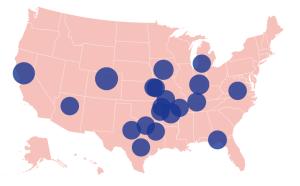Here's why the rental market can differ from city to city
Dwellsy is a Cashay content contributor. It’s also an apartment-listing site that provides easy-to-use tools to find, sort, and share the homes you like.
Looking for a new place to rent can be very challenging, especially considering how rental prices vary so drastically from one property to the next. Even the rental market changes greatly from city to city.
Luckily, we’ve compiled a list of reasons why the rental market differs across cities, so that you can develop a better understanding of the rental market and increase your chances of finding a home.
Variations in supply and demand
This is a basic economic principle that offers the most reasonable explanation as to why rent prices vary in each U.S. city.
Simply put, the principle refers to the comparison between the amount of goods and services available (supply) against the amount of goods and services that people want to buy (demand).
When the supply of apartments exceeds the demand for renters, the rental prices are likely to be lower in that particular region or city. Similarly, when the demand for renters for an apartment exceeds the supply, apartment prices will increase.
This is primarily why rent prices vary across neighborhoods, cities, and countries. It’s also why the cost of rent in certain areas is drastically lower than the national average.
Population
Closely tied to supply and demand, population density is another cause for rental price differences. For instance, a city with a larger population density is likely to have higher rental costs, whereas cities with low populations will have lower rent prices. That is because, as the population increases, the demand for rental apartments also increases, thereby leading to a boost in the rent.
Municipal rates
There’s a specific fee plus tax that apartment complexes are required to pay to the city’s local government or municipality. The rate of this fee varies according to the location as well as the municipal area.
If these municipal rates are high in a particular city, the rent prices are also likely to be high. Similarly, if the municipal rates are low, rent prices will also be low.
Time of year
As strange as it may sound, the time of the year greatly affects apartment prices.
For example, the summer season is usually considered the ‘moving season,’ during which students are in search of a nice rental apartment near their college or university. Families also are looking for a place to move since the kids are out of school and many other such factors.
Colleges and universities in different cities have varied semester timings, which greatly affects the demand/supply for rental apartments.
So, when there’s a high demand in a particular city during a specific time of year, rent prices will be higher. When the demand is low, prices will also be lower.
Some areas are more impacted than others. The proximity of a major university, for example, might increase the pricing pressure on rental units available at the start of terms. Similarly, people are less likely to move in the winter in areas with more severe weather than they would be in places like Florida or Southern California. This is another reason why the rental market is so different from city to city.
Apartment location
The location of apartments plays such a huge role in their rent prices.
If an apartment is located in a city’s most posh area, you can expect the prices to be much higher in comparison to other nearby cities. On the other hand, if a similar kind of apartment is located in a less-popular area, rent prices are likely to be lower.
Other factors like proximity to public transportation or fun restaurants and stores can also have a significant impact on rent prices in a neighborhood, as does relative crime rates and even the availability of parking. Be sure to keep that in mind during your rental search.
Square footage
The rental prices are also directly related to square footage. A bigger home will almost always be more expensive than a home with the same amenities and a smaller square footage. Of course, location also heavily influences pricing, which is why a studio apartment in Los Angeles is likely to be more expensive than one in Springfield, Michigan.
Cost of living
As you might already know, the cost of living in two different cities is nowhere near the same. If there’s an upward shift in the prices of consumer goods and services in a particular city, it will also increase rent prices. On the other hand, if the prices of goods and services in a city face a decline, the rent prices are likely to decrease as well.
Key takeaway
As you can tell, there are many factors contributing to inconsistencies in rental prices from city to city and even neighborhoods within a city. From supply and demand to population density to municipal rates, each factor has the potential to influence the rent prices across different cities.
To find a rental that best fits you, delineate what amenities and property attributes are most valuable to you and adjust your search accordingly. For example, if you are looking to live in a place that has a high cost of living but have no preferences for square footage, you may want to consider downsizing to find a more affordable place.
Read more information and tips in our Renting section




